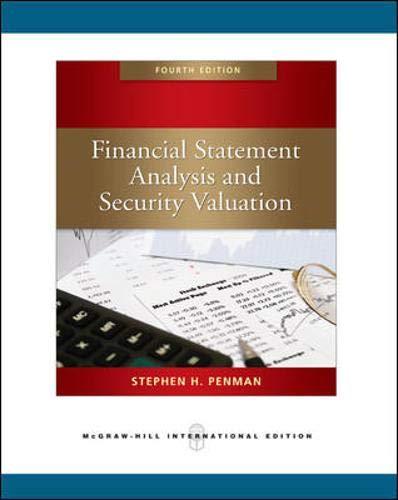E15.9. Comprehensive Analysis and Valuation (Hard) This exercise comes in two parts. Part I involves an analysis
Question:
E15.9. Comprehensive Analysis and Valuation (Hard) This exercise comes in two parts. Part I involves an analysis of a set of financial statements and Part II involves forecasting and valuation based on those financial statements. Part I: Analysi The following is a comparative balance sheet for a firm for fiscal year 2009 (in millions of dollars): 2009 2008 2009 2008 Operating cash $ 60 $ 50 Short-term investments Accounts payable Accrued liabilities $1,200 $1,040 350 450 (at market) 550 500 Accounts receivable 940 790 Long-term debt 1,840 1,970 Inventory 910 840 Property and plant 2,840 2,710 Common equity 1,870 1,430 $5,900 $4.890 $5,300 $4,890 The following is the statement of common shareholders' equity for 2009 (in millions of dollars): Balance, end of fiscal year 2008 Share issues from exercised employee stock options Repurchase of 24 milion shares Cash dividend Tax benefit from exercise of employee stock options Unrealized gain an investments Net income Balance, end of fiscal year 2009 $1,430 810 (720) (180) 12 50 468 $1,870 The firm's income tax rate is 35 percent. The firm reported $15 million in interest income and $98 million in interest expense for 2009. Sales revenue was $3,726 million.
a. Calculate the loss to shareholders from the exercise of employee stock options during 2009.
b. The shares repurchased were in settlement of a forward purchase agreement. The mar- ket price of the shares at the time of the repurchase was $25 each. What was the effect of this transaction on the income for the shareholders?
c. Prepare a comprehensive income statement that distinguishes after-tax operating in- come from financing income and expense. Include gains or losses from the transac- tions in parts
(a) and
(b) above..
d. Prepare a reformulated comparative balance sheet that distinguishes assets and liabili- ties employed in operations from those employed in financing activities. Calculate the firm's financial leverage and operating liability leverage at the end of 2009.
e. Calculate free cash flow for 2009. Part II: Forecasting and Valuation Use a cost of capital for operations of 9 percent. Sales revenue is forecasted to grow at a 6 per- centrate per year in the future, on a constant asset turnover of 1.25. Operating profit mar- gins of 14 percent are expected to be earned each year. Forecast return on net operating assets (RNOA) for 2010.
b. Forecast residual operating income for 2010.
c. Value the shareholders' equity at the end of the 2009 fiscal year using residual income methods.
d. Forecast abnormal growth in operating income for 2011.
e. Value the shareholders' equity at the end of 2009 using abnormal earnings growth methods.
f. After reading the stock compensation footnote for this firm, you note that there are employee stock options on 28 million shares outstanding at the end of 2009. These options vest in 2011 and after. A modified Black-Scholes valuation of these options is SIS each. How does this information change your valuation? g Forecast (net) comprehensive income for 2010. Applications
Step by Step Answer:

Financial Statement Analysis And Security Valuation
ISBN: 9780071267809
4th International Edition
Authors: Penman-Stephen-H, Steven Penman





